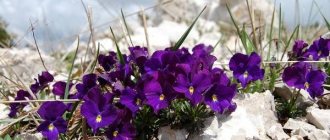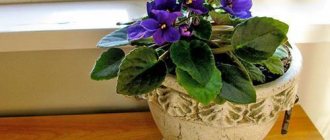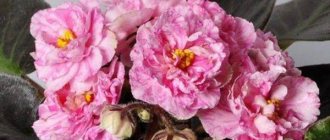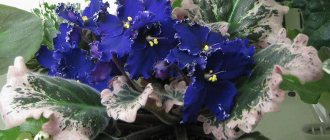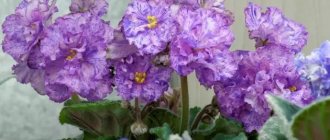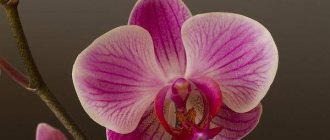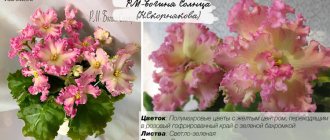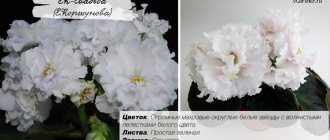Flower growers usually do not give preference to one color - each flower is good in its own way. Many “violet growers” love purple violets; it combines red and blue colors. They say that purple is the color of wisdom and spirituality. It is loved by intellectual people, poets and philosophers. This noble color helps to establish harmony between people, spiritual kinship and mutual understanding. There are so many varieties of purple violets that it is simply impossible to write about them in one article. Therefore, for now we will only talk about five beauties. More on the rest a little later.
Violet Baltika
The delicate blue-violet flower belongs to the semi-double species of the Gesneriaceae-Saintpaulia family. The tips of the wavy leaves are jagged, with a gradient white edge that looks very impressive. Rosette of light rich green color. Baltika violet is a large, compact flower, with wide leaves that create a voluminous “foamy cloud”.
Problems that a florist may encounter
You should always pay close attention to the condition of the plants. It is important to promptly prevent the spread of diseases and pests. Diseases relevant to Saintpaulia ek:
- fungal diseases;
- root rot;
- stem rot;
- leaf rust;
- gray rot;
- late blight;
- powdery mildew;
- vascular bacteriosis.
Additional Information! Due to elevated temperatures, red mites may appear in the flower. When the first “guests” appear, the violets are immediately treated with insecticidal agents.
- flower thrips;
- cyclamen mite;
- aphid;
- scale insects;
- woodlice;
- sciarids;
- nematodes.
Violet Currant dessert
The color of the leaves is real blackcurrant jam! Violet Currant dessert is a semi-double variety. Beautiful, rather large leaves are velvety, with green edges turning into light pink. Flower growers advise beginners to start with this fluffy violet, because it is completely unpretentious, despite all its beauty.
Difference in names
Saintpaulia and Uzambara violet are the names of the same plant, which is cultivated at home. Saintpaulia is the Latin scientific name, and Uzambara violet is the folk name . People began to call Saintpaulia Uzambara violet because in its natural environment the plant is found in the Uzambara Mountains.
Viola is the Latin name for violet, which is grown in gardens.
Purple
Currant dessert
Currant dessert
They take the shape of stars, they are very fluffy and semi-double. Along the edges of the petals there is a fringe of an unusual color : it resembles the shade of jam made from black currants. The velvety leaves are colored green. The variety is quite unpretentious, suitable for beginners.
Winter rose
Violet Winter Rose
The shape of the flowers strongly resembles pink inflorescences, which is why the variety has this name. The petals are dark blue-violet. There is a thin snow-white edging along the edges . Small leaves are colored rich green. Winter rose conveys the qualities of the variety well.
Baltika
Violet Baltika
Leaves with jagged tips form a compact rosette of bright green hue. They are classified as semi-double. They grow to impressive sizes and are colored blue-violet. Along the edges there is a wide, blurry white border .
White
Aly's Blizzard Bunny
Violet Alice Blizzard Baths
Snow-white flowers are small in size and strongly reminiscent of stars. The variety is classified as semi-double . The heart-shaped leaves are a rich green color. This species is very popular among amateur gardeners.
Snow lace
Violet Snow lace
The variety is characterized by lush double flowers of a snow-white hue. There is a bluish spot in the center . The edging of the petals shines with a barely noticeable greenish tint. It blooms very actively and luxuriantly. The leaves are colored light green.
The bride's bouquet
Violet Bride's Bouquet
It was bred by Russian breeder Konstantin Morev. Large delicate white flowers in the shape of a star with wavy edges are very similar to a wedding bouquet . Blooms profusely. The petals have an even color, there are no inclusions or patterns.
Pink
Georgia
Violet Georgia
A variety of fabulous beauty. Large double flowers consist of rich pink petals, along the edges of which lilac inclusions are scattered . The wavy edges of the petals are decorated with a thin light green border. Flowers bloom on powerful peduncles. Blooms profusely if the necessary conditions are met.
Marquise
Violet Marquise
The variety was developed in 2011. Blooms large double flowers of a rich pink hue . Along the edge of the petals there is a lilac border with a thin snow-white line. The leaves are dark green. Looks great on the windowsill.
Magdalene
Violet Magdalene
Foliage is colored green. Large double flowers resembling a ball bloom in the middle of the rosette. The petals have a wavy edge. The flowers are located very close to each other, which creates the impression of a huge bouquet . Very popular at exhibitions. Many people acquire leaves of this variety.
Lilac
Lilac beauty
Violet Lilac beauty
This variety is distinguished by large purple flowers with speckles of rich lilac color in the center. There is a dark border at the edge of the petals. The flower stalks are powerful, the rosette of regular shape consists of round leaves . This variety is easy to care for and is suitable for beginners and even children.
Favorite daughter
Violet Beloved Daughter
Flowers of a rich lilac color with a border painted in dark purple. The serrated leaves are round in shape and emerald green in color . The reverse side has a clear raspberry tint. Flowers are born small and dark. As they develop, they become lighter. It can lift leaves up, so it needs a lot of space on the windowsill. Beautiful and lush flowering almost always pleases the gardener. They bloom for two to three weeks.
Blue
Blue Dragon
Violet Blue Dragon
A widely known variety of Sorano selection. Almost all collectors have this variety. Popular for its large, soft blue flowers . A white-greenish border stretches along the edges of the petals. The variety is quite capricious. It needs a natural source of light and does not tolerate agricultural errors.
Blue Danube
Violet Blue Danube
Bred by Russian breeders. It is characterized by large flowers that reach five centimeters in size. The petals are colored pale blue. Matte leaves with wavy edges have small denticles at the end . This variety needs good lighting and proper watering. The abundance and duration of flowering depends on temperature.
Blue Lagoon
Violet Blue Lagoon
The variety is characterized by large semi-double flowers of a rich blue hue, reminiscent of a star shape. It has a blue spot in the center, and a purple border runs along the edges. When there is insufficient light, it raises the leaves upward . Flowering duration is two months. Easy to care for, even a beginner can grow it.
Variegated
lemon snow
Violet Lemon Snow
The flowers are snow-white with lemon-colored rays. The middle and edges have a bluish tint. The leaves are variegated and painted a rich green color . There is a white border along the edge of the leaf.
Willodene
Violet Willodene
A variety with unusually beautiful variegated leaves. Peach flowers with a greenish edge are not the main attraction. At exhibitions, attention is paid to the wavy leaves, colored emerald , diluted with pink and white spots.
Gift for a loved one
Violet Gift for a loved one
The deep green leaves with sharp tips and pink-white edging are of particular value . The flowers are blue. There is a purple border along the edge. Enjoys great success at exhibitions. Quite an unpretentious variety.
Ampelous
Ampelous violets are used for growing in hanging pots. They decorate hanging flower beds and gardens. They have several growing points, long stems hanging down, and a large number of side shoots. The most popular varieties of ampelous violets are Trinket Summer Skyes with rounded green leaves and blue flowers and Robs Humpty Doo with light leaves and snow-white flowers.
Violet Trinket Summer Skies
Violet Robz Humpty Doo
They need a lot of light. They are able to bloom throughout the whole year . In winter, the plant is provided with additional lighting.
Mini varieties
The rosette of miniature violets does not exceed fifteen centimeters in size . At the moment, about two thousand varieties of mini-violets are known.
Mini violets are very popular among gardeners.
Many collectors only collect miniature violets. Caring for miniature violets has some features : they are less whimsical than their larger counterparts.
Among the mini-varieties, Avatar can be distinguished with simple semi-double flowers of a soft blue hue and variegated leaves. Flower growers are also attracted by a delicate variety called My Angel . Simple flowers on powerful peduncles are colored pink. The leaves are soft green in color and have a wide snow-white edge.
Violet Avatar
Violet My angel
Turquoise jellyfish
Family - Gesneriaceae-Saintpaulia. More turquoise than purple, the leaves are double and fluffy, and can grow up to 7-8cm in diameter. The soft green rosette is compact and creates a “complete” picture. Violet Turquoise jellyfish always blooms in a “cap”; its flower stalks do not stretch out. It blooms often and profusely, but does not like heat.
Winter rose
Dark purple flower buds, similar to roses, with snow-white edges. Violet Winter Rose is considered an industrial variety. It is easy to care for, it is unpretentious and easily gets along in any room. The shoots of the plant are numerous, branching, shortened, and the “buds” are large, creating a lush head. The leaves are dark green, lighter on the inside. Winter rose loves moisture, but it cannot be sprayed. You can get out of the situation by simply placing a container of water next to it.
How to care?
Uzambara violets are one of the few representatives of the world of ornamental flora that can delight their owner with riotous flowering for a significant part of the year. With proper care and attention, these responsive plants can bloom for up to 10 months, leaving very little time for recovery. In order for Saintpaulias to bloom long and luxuriantly, they need to provide the following conditions:
moderate watering regime;
Lighting
Saintpaulias are plants that require abundant but diffused light. A sufficient amount of light during the day provides them with a full process of photosynthesis, thanks to which Uzambara violets can develop and bloom normally.
To increase the duration of flowering, experienced plant growers use additional illumination using phytolamps or fluorescent lighting sources.
Irrigation mode
Uzambara violets are quite tolerant of mild drought, which is less harmful to them than heavy watering. In order for plants to feel good, it is necessary to provide them with regular but moderate watering. Saintpaulias are watered only with settled soft water at the same temperature as the air temperature.
The difference between air and water temperatures should be no more than 5°C.
Air temperature
Saintpaulias are heat-loving plants that are sensitive to drops and changes in air temperature. Experienced gardeners recommend maintaining the temperature in the room where Uzambara violets grow at a stable level of 25°C. A decrease in temperature to 15°C or an increase to 30°C has a detrimental effect on the condition of Saintpaulias. Under such conditions, they stop developing, stop flowering, and in some cases die altogether.
Midnight Velvet (Sorano)
Midnight Velvet (Sorano), as the name of this violet sounds in English, has strong leaves stretching upward. Velvet dark blue flowers shimmer with a purple tint. The thin white border on the leaves emphasizes the beauty of the plant, which is truly very impressive! Although the flowers are small, there are many of them and they delight their owners with long-lasting flowering. The variety reproduces easily and loves cool, bright rooms. Don't be scared by the first flowering - the violets will look like pansies. But next time the Midnight Velvet violet will delight you with its terry miracle.
The most beautiful varieties of indoor violets
Violets are one of the most popular indoor flowers. There is an incredible number of their varieties. Plants are distinguished by their exquisite beauty and variety of colors. In thematic magazines and the Internet you can see photographs in which the interior of a room, kitchen or loggia looks incredibly cute and cozy thanks to pots of multi-colored violets.
Violet or Saintpaulia
The plant, known to all lovers of indoor floriculture, has other names: Saintpaulia (Saintpaulia in Latin), Usambara violet. From the point of view of scientific classification, Saintpaulia has no relationship with the violet, which grows naturally in the northern hemisphere.
These flowering plants even belong to different families: violets belong to the violet family, and Saintpaulias belong to the genseriaceae. Moreover, the plants are similar in appearance, which explains the use of the same name in colloquial speech.
Gallery: indoor violets (25 photos)
Saintpaulias are perennial herbaceous plants with a fibrous root system. This means that the root system is formed by adventitious roots, and the main root is absent.
The arrangement of Saintpaulia stems varies depending on the type of plant. There are varieties with short stems and basal leaves that form a rosette. An option with long branched stems and several hanging rosettes (ampeloid violets) is also possible.
Saintpaulia leaves can have a round, oval or ovoid outline. The edges may be rounded or jagged. The leaves are flat, wavy or slightly corrugated. There are species with matte and glossy leaf surfaces.
Most varieties of violets have leaves of varying shades of green. The palette can be diluted with olive, cream, golden, ash and pink colors, including in the form of veins at the base or along the edges of the sheet or in the form of a bright mosaic. The reverse side of the leaf is usually painted silver-gray, to which shades of red are sometimes added.
There are types of indoor violets with simple, semi-double and double petal structure. In the first case, the petals in the flower are arranged in one row. With a semi-double structure there are two or three rows, with a double structure there are more than three rows.

